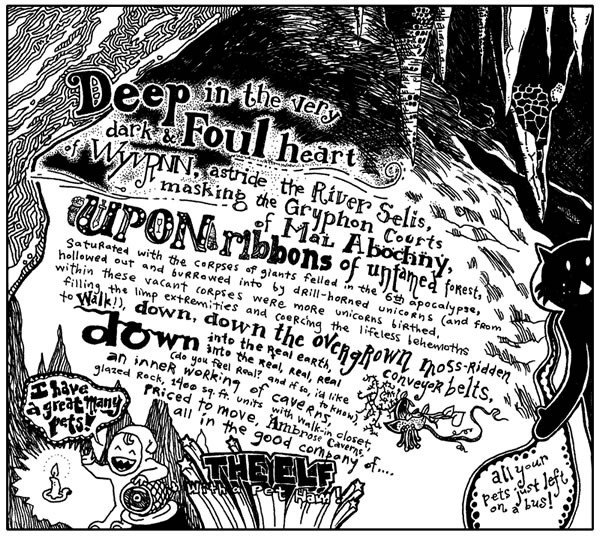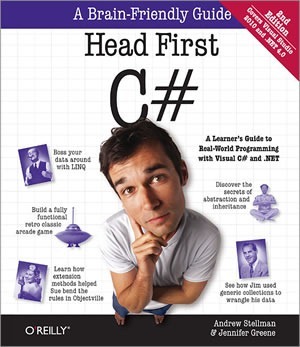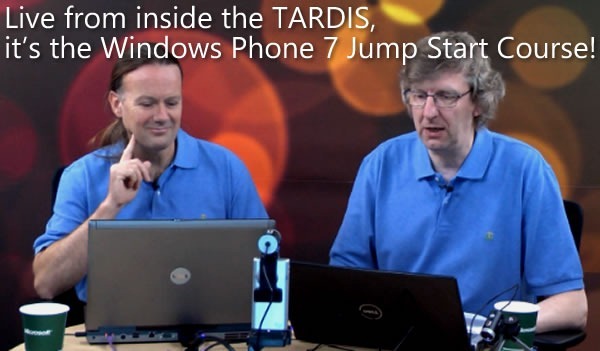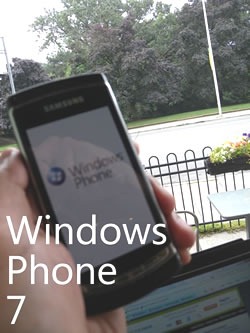A hilarious worst-case scenario involving Facebook and a job interview. Contains some weird adult situations, which is why it’s so funny:
This article also appears in The Adventures of Accordion Guy in the 21st Century.
A hilarious worst-case scenario involving Facebook and a job interview. Contains some weird adult situations, which is why it’s so funny:
This article also appears in The Adventures of Accordion Guy in the 21st Century.
In case you hadn’t yet seen Windows Phone 7 in action, here’s a video that was shot recently:
I get a lot of questions about Windows Phone 7 development, and of these, the most often-asked one is “How do I get started building apps for Windows Phone?” My answer is always the same: take a guide or tutorial that suits you, learn how the example program works, and then start experimenting!
If you really want to dive into the world of Windows Phone development, you should check out DevTeach’s two-day intensive bootcamp hosted by Colin Melia, who’s presented at TechDays, wrote the Silverlight demo app that we used for the EnergizeIT tour and is one of our go-to guys for Windows Azure – simply put, the guy knows his stuff. If you’re looking to kick-start your WP7 development, there isn’t a course more hardcore than this one.
The first bootcamp takes place next week in Montreal at the Microsoft offices on Avenue McGill College. The registration fee is $999, but you can save $100 with the discount code WP7BOOTCAMP. Register today!
 Today, August 19th, is WhyDay, a day held in honour of the Ruby world’s most enigmatic character, a guy known to most only by a nickname, why the lucky stiff.
Today, August 19th, is WhyDay, a day held in honour of the Ruby world’s most enigmatic character, a guy known to most only by a nickname, why the lucky stiff.
_why (as he’s often called) is probably best known for his quirky programming book, why’s (Poignant) Guide to Ruby, quite possibly the most weird and whimsical tutorial written since Carlton Egremont III’s books Mr. Bunny’s Big Cup O’ Java and Mr. Bunny’s Guide to ActiveX. Although he never finished the book, it’s still a great (and greatly amusing) intro to the Ruby programming language from simple one-liners, all the way up to metaprogramming, peppered with his crazy comics which include two cartoon foxes whose catchphrase/battle cry is “chunky bacon!”.

_why also wrote a number of libraries and applications, many of which have either become part of the Ruby programmer’s toolkit or have become the basis of current apps and libraries. He was also a big proponent of making programming environments to teach kids programming, so he created Shoes, a UI toolkit for making web-like desktop apps and Hackety Hack, a programming mini-IDE built on top of Shoes for kids to make their own programs.
He didn’t stop at writing and coding; he was also a musician and performer. If you were at the first RailsConf in 2006 in Chicago, you were treated to his keynote, a psychedelic multimedia rock opera which began with him exhorting the audience to “Put you best practices away!” and filled with great music and geeky jokes (including one about exception handling that I found particularly amusing).
_why has always been a bit of a privacy nut, to the point that very few people actually know his real name or even what he does for a living. On this day last year – August 19th, 2009 – he decided that he no longer wanted to be in the spotlight and quietly disappeared from the Ruby scene, removing all traces of his sites and projects. John Resig, they guy behind jQuery, wrote a nice elegy for him (even though _why didn’t pass away, but went into J.D. Salinger mode).
His stuff lives on because it was all either open-sourced or licenced under Creative Commons, and is now curated (and even expanded upon) by fans of his work.
A number of people are celebrating WhyDay by remembering his greatest gift to the Ruby and larger programming world: a spirit of whimsy, creativity, freedom and experimentation. Yes, programming is serious work and probably one of the hardest things that humans do, but without finding joy in what you do, what’s the point? The people who’ve declared today as WhyDay suggest:
I’d be a bad Microsoft evangelist if I didn’t tell you that:
 Andrew Stellman, co-author of O’Reilly’s excellent and easy-to-read C# intro, Head First C#, is holding a week-long “Inner Circle” discussion on C# and .NET 4.0 in the forums for O’Reilly’s “Head First” book series. In this discussion, he plans to cover a wide range of topics, including:
Andrew Stellman, co-author of O’Reilly’s excellent and easy-to-read C# intro, Head First C#, is holding a week-long “Inner Circle” discussion on C# and .NET 4.0 in the forums for O’Reilly’s “Head First” book series. In this discussion, he plans to cover a wide range of topics, including:
If you want to follow the discussion, simply point your browser at the Head First Labs Forums’ “Head First C#” section and look for topics started by Andrew Stellman. You don’t have to log in to just read, but you’ll have to register for the forum if you want to join in the discussion and comment back.

In his first discussion topic, Andrew issues a challenge: build an old-school, text-mode game in C#! In the 1980s, the computing world was seen through the command line in an 80-character by 24-line grid (40 characters if you were on an Apple ][, Commodore 64 or Atari 400/800, even fewer if you were on a VIC-20), and that’s how we played a lot of games, whether they were commercial or typed in from source code in magazine or books like the ones scanned into the Atari Archives.
If you’ve never written a text-mode game before (or in my case, if it’s been a long, long time), he’s written an article to help out — Understanding C#: Use System.Console to Build Text-Mode Games.
Your efforts in building an old-school text-mode game will not go unrewarded. Submit a text-mode game and you can win a prize! He’ll judge them on the following criteria:
The winner will receive five O’Reilly eBooks of his or her choice. He’ll also choose runners-up who will get a free O’Reilly eBook.
If you’re looking for ideas for an old-school text-mode game, check out these books at Atari Archives, with source code written in old-school line-numbered BASIC. Some of these take me back to my high school days:
As a prelude to the discussion, Andrew recorded videos of his answers to questions about the C# programming language and the second edition of Head First C#…

(Well, it’s two English guys surrounded by tech gear and a psychedelic background. The interior of the TARDIS came to mind.)
The Windows Phone 7 Jump Start is the first of a number of free online courses on WP7 programming led by Microsoft MVPs, and you can jump in right now! Presented by Andy Wigley and Rob Miles, the Jump Start is made up of 12 50-minute videos for a total of ten hours’ worth of training, covering development of both Silverlight- and XNA-based apps as well as advanced topics such as the WP7 application lifecycle, launchers, choosers, isolated storage, taking advantage of the dialer, camera and contacts, and networking. There’s even a section on bringing your app over to the Marketplace. It’s all online, free and ready for you to dive in!
The videos in the course are:
You can watch the videos on their pages (Silverlight required) or download them in WMA, WMV and MP4 formats for offline viewing.
And now a special TechDays announcement from Damir, the Big Kahuna of our upcoming cross-Canada conference…
 TechDays 2010 is getting closer with Vancouver conference just a few weeks away. As such the team has been hard to make this an impactful event that will allow you to grow your skills and support you in areas important to your job and career.
TechDays 2010 is getting closer with Vancouver conference just a few weeks away. As such the team has been hard to make this an impactful event that will allow you to grow your skills and support you in areas important to your job and career.
I am happy to announce that the hard work has paid off and we have been able to work with Microsoft corporate and each TechDays 2010 attendee will get a TechNet Plus subscription!
This benefit is added to the over 50 Sessions of technical content, networking opportunities, great offers from our Partners, like Telerik, Pluralsight, Xceed, and access to 50 virtual labs to get hands-on without requiring you to provide the necessary hardware and software to support adoption.
Now, to be clear, I did announce just a couple of weeks ago that we would not be providing TechDays 2010 attendees with TechNet Plus subscriptions, but understanding that now, more than ever, you need all the tools in your arsenal to help you deploy Windows 7 and Office 2010, implement Windows Server 2008 R2, Hyper-V, SharePoint 2010, and other technologies, we were able to work with our colleagues at Microsoft Corporate to make a one-time exception.
Here are some details on how the TechNet subscription will work for TechDays 2010 attendees:
Finally, there is one more thing I need to be completely clear about. The provision of a one-year TechNet subscription to TechDays 2010 attendees is a one-time only occurrence and will not be continued in future years. I’ll be up-front right now – we do not expect to provide TechDays 2011, and future year, attendees with TechNet subscriptions. We are delighted that we can do it this year but want you to be aware that you should not expect to receive a TechNet subscription in 2011 and further into the future.
If you have not yet registered, please go to www.techdays.ca to get the limited-time Early Bird pricing at $349.99 + taxes, a 50% saving from the regular conference fee. If you plan on going to TechDays Vancouver, Early Bird pricing expires on August 20th so act now! Early Bird pricing for TechDays 2010 events in other cities expires 6 weeks before the event.
Thanks for your continued support of TechDays. We look forward to welcoming you!
Damir
When Windows Phone 7 was first shown to the public in March, we got a taste of the Games hub and were told that Microsoft was working with a number of big game developers to bring games to the new phone platform. Late yesterday, we got the announcement of the first games coming to WP7:
It’s one thing to see a slickly-produced ad showing the games, but it’s an entirely different thing to see actual games being played on an actual phone. Here’s Engadget’s video of the game experience on one of the prototype phones – the Samsung “Taylor”, which I have and which you might have seen at the last “Coffee and Code” event in Toronto:
Here’s what Engadget had to say about the experience:
We’ll preface this by saying that both the hardware and software we demoed was still unfinished (the latter being the Samsung Taylor dev phone and the LG QWERTY model we broke news of on the Engadget Show). Regardless, the gameplay for the arcade titles seemed excellent, with frame rates holding fast even during graphically intensive 3D sequences (such as the chaotic, scattered-pixel play of Rocket Riot). The Harvest, while a bit familiar to our eyes, still showed the graphic promise of the platform. Gameplay was definitely well suited to a touchscreen device, though Microsoft’s Kevin Unangst told us that developers could target controls for both touch and QWERTY-equipped phones (provided that a touch version was always present). The screen response seemed accurate and sensitive, reacting quickly to our input. Particularly in the Crackdown title — a tower defense game "set in the Crackdown universe" — pinch zooming, rotation, and finger tracking was excellent.
The “New Xbox Experience” or “NXE” – the revamped Xbox user interface that introduced avatars – comes along for the ride on Windows Phone. You can access your Xbox Live account on WP7, check out your gamerscore and achievements, and like Xbox-based games, your avatar can also be used within WP7 games and apps.
In this Engadget video, we see avatars being used to give a little twist to some standard smartphone apps such as “flashlight”, “spirit level” and “coin flip”:
Here’s another video showing more avatar action as well as some of the social networking features of Xbox Live, as done on WP7:
The games that have been announced for Windows Phone 7 so far:
…with more on the way, as big game dev companies sign up and Microsoft’s Mobile Games Studio kicks into high gear.
 If you want to just play Windows Phone 7 games, it’s easy – the phone comes out in the fall, in time for the holiday shopping season.
If you want to just play Windows Phone 7 games, it’s easy – the phone comes out in the fall, in time for the holiday shopping season.
If you want to build Windows Phone 7 games, it takes a little more work, but it’s worth it. You’ll need to: